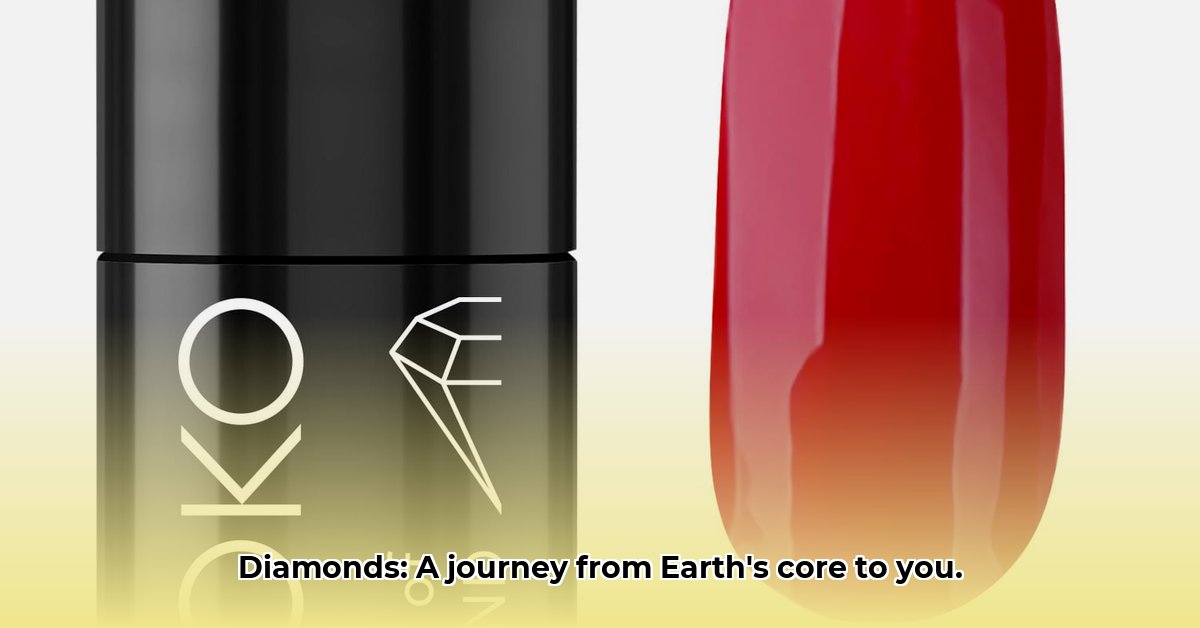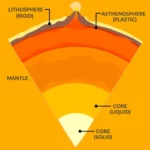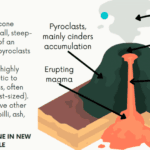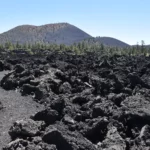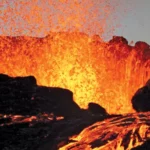Diamonds: those glittering symbols of love and luxury. But beyond their beauty lies a fascinating story of extreme conditions and geological processes. Have you ever wondered how these remarkable gems are formed deep within the Earth and brought to the surface? This article explores the incredible journey of diamonds, from their fiery origins in the Earth’s mantle to their final destination in our jewelry boxes. For more on Earth’s powerful forces, learn about tectonic plate activity.
Unveiling Diamond Origins: A Journey into the Earth’s Depths
Diamonds, coveted for their brilliance and rarity, are forged in the crucible of the Earth’s interior. The formation process is a testament to the power of extreme pressure, intense heat, and geological forces. Let’s embark on a scientific journey to understand how these precious stones emerge from the planet’s depths.
Deep Earth’s Pressure Cooker: The Birthplace of Diamonds
Diamonds are born in the Earth’s mantle, typically at depths of 150 to 250 kilometers (93 to 155 miles). To crystallize carbon into a diamond, a very specific set of circumstances must be met. This zone experiences immense pressure, ranging from 4.5 to 6 gigapascals (GPa), equivalent to 45,000 to 60,000 times the atmospheric pressure at sea level. Simultaneously, temperatures must soar between 900 and 1,300 degrees Celsius (1,652 to 2,372 degrees Fahrenheit).
These extreme conditions force carbon atoms to bond in a unique and exceptionally strong tetrahedral crystal structure that gives diamonds their famed hardness and brilliance. At lower pressures and temperatures, carbon atoms would form graphite, a much softer and less valuable mineral. Imagine squeezing coal with the force of a mountain range and heating it to the point of melting iron – that’s the essence of diamond formation, revealing the importance of Deep Earth Pressures and Temperatures Role in Diamond Crystallization.
Diamond Diversity: Lithospheric vs. Superdeep
Not all diamonds originate from the same depth. Most commercial diamonds are lithospheric diamonds, which form in the Earth’s lithosphere – the rigid outer layer comprising the crust and uppermost mantle. These diamonds typically contain small amounts of nitrogen, implying they crystallize from carbon- and nitrogen-bearing fluids.
However, there exists another type of diamond: superdeep diamonds. These remarkable gems come from depths exceeding 410 kilometers (255 miles), and potentially as far down as 800 kilometers (497 miles) or even deeper, within the Earth’s transition zone and lower mantle. Superdeep diamonds often contain very little nitrogen and are relatively pure, sometimes containing boron, which can impart a blue hue.
The extreme depths at which superdeep diamonds form result in unique characteristics. They often exhibit different trace element compositions and may contain inclusions of minerals not found in lithospheric diamonds, highlighting How to Identify Superdeep Diamonds Based on Trace Element Analysis. Examples include inclusions of calcium silicate perovskite, a mineral only stable at the immense pressures of the lower mantle. These differences provide clues about the deep Earth’s composition and processes, particularly regarding the recycling of surface materials into the deep mantle through subduction.
Kimberlite and Lamproite Eruptions: Elevators to the Surface
Once formed, diamonds remain trapped deep within the Earth unless a specific geological event transports them to the surface: Kimberlite and Lamproite eruptions. Kimberlites and lamproites are rare types of volcanic eruptions characterized by their exceptional depth of origin and rapid ascent. These eruptions act like geological express elevators, carrying diamonds from the mantle to the Earth’s surface in a relatively short amount of time. The speed is essential to prevent the diamonds from transforming back into graphite, so they don’t dissolve due to changes in pressure and temperature.
Kimberlite pipes, named after Kimberley, South Africa, where diamonds were first discovered in this type of rock, are the most significant source of diamonds. However, only a small fraction of kimberlite pipes actually contain gem-quality diamonds.
Diamond’s Tiny Time Capsules: Inclusions
Diamonds are not always flawless, despite what advertising might have you believe. Many diamonds contain inclusions: tiny mineral crystals or fluids trapped within the diamond’s structure during formation. These inclusions are like miniature time capsules, preserving samples of the environment in which the diamond grew.
Scientists can analyze diamond inclusions to determine the temperature, pressure, and chemical composition of the fluids from which the diamond formed. This provides direct evidence about Earth’s deep interior, offering insights into mantle processes that would otherwise be impossible to obtain. For example, the presence of specific minerals like olivine or garnet within an inclusion can indicate the depth and origin of the diamond. What if these imperfections are actually the key to understanding the Earth’s history?
Unresolved Mysteries: What Remains to Be Discovered
Despite significant advances in our understanding, several questions about diamond formation remain unanswered. One ongoing debate concerns the precise mechanisms of carbon transport in the deep mantle. How does carbon reach the depths necessary for diamond formation, and what form does it take? Is it primarily through subduction of carbon-bearing materials, or are there other sources of carbon in the deep mantle?
Another area of active research focuses on the role of fluids in diamond formation. What is the composition of these fluids, and how do they influence diamond growth? Do diamonds form from carbonate-rich fluids, silicate melts, or a combination of both? Furthermore, understanding the relationship between lithospheric and superdeep diamonds remains a challenge. Do they form in entirely separate environments, or is there a connection between the two?
- Diamonds require both immense pressure and high temperatures to form deep in the Earth’s mantle.
- Kimberlite and lamproite eruptions act as geological elevators, bringing diamonds to the surface.
- Inclusions within diamonds preserve tiny samples of the deep Earth, aiding scientific research.
Trace Element Analysis: Identifying Superdeep Diamonds
Superdeep diamonds, originating from depths exceeding 410 kilometers, are of particular scientific interest due to their unique properties and the insights they provide into the deep Earth. How to identify superdeep diamonds based on trace element analysis relies on sophisticated techniques to analyze the chemical composition of the diamonds and their inclusions.
Unique Signatures
Superdeep diamonds often exhibit distinct trace element signatures compared to their shallower counterparts. For example, they may have lower concentrations of nitrogen or contain inclusions of minerals only stable at extreme depths, such as majorite garnet or calcium silicate perovskite. By carefully measuring the concentrations of different elements and their isotopic ratios, scientists can determine the origin of a diamond and distinguish superdeep diamonds from those formed at shallower depths.
Advanced analytical techniques like secondary ion mass spectrometry (SIMS) and laser ablation inductively coupled plasma mass spectrometry (LA-ICP-MS) are crucial for these analyses, allowing scientists to measure trace element concentrations at the parts-per-billion level. The carbon isotope composition of superdeep diamonds can also provide clues about their origin.
- Superdeep diamonds form at significantly greater depths than other diamonds, under extreme pressure and temperature.
- How to identify superdeep diamonds based on trace element analysis involves sophisticated techniques to measure trace element abundances and isotopic ratios.
- Kimberlite and lamproite eruptions are crucial to bringing these deep-earth treasures to the surface.
Deep Earth Pressures and Temperatures: The Diamond-Forming Recipe
The recipe for diamond formation requires two key ingredients: immense pressure and scorching temperatures. The importance of Deep Earth Pressures and Temperatures Role in Diamond Crystallization cannot be overstated. Without these extreme conditions, carbon atoms would not be able to bond together in the unique and stable structure that defines a diamond.
The Right Conditions
Imagine squeezing carbon atoms together with unimaginable force while simultaneously heating them to temperatures high enough to melt rock. The immense pressure, reaching several gigapascals – millions of times greater than atmospheric pressure – forces carbon atoms into a tightly packed, stable crystalline structure: diamond. The high temperature provides the energy for this atomic rearrangement to occur. The most important thing to note about these diamonds is the Deep Earth Pressures and Temperatures Role in Diamond Crystallization.
The specific pressure and temperature conditions required for diamond formation depend on depth. Lithospheric diamonds typically form at pressures of 4.5 to 6 GPa and temperatures of 900 to 1300°C, while superdeep diamonds require even more extreme conditions. Some research indicates that super-deep diamonds can also form in metallic melts in the deep earth.
- High-pressure, high-temperature (HPHT) conditions are essential: Diamonds form deep within the Earth’s mantle under immense pressure (4.5-6 GPa, reaching up to 152 GPa for super-deep diamonds) and intense heat (900-1600°C). This forces carbon atoms into the incredibly strong diamond lattice structure.
- Multiple carbon sources contribute: Subducted oceanic plates, primordial mantle carbon, and carbonate-rich melts all provide the raw carbon material.
- Kimberlite and lamproite eruptions are crucial transport mechanisms: These volcanic eruptions bring diamonds from the mantle to the Earth’s surface. Without them, we’d never see these treasures.
Kimberlite and Lamproite Eruptions: Diamond’s Explosive Delivery
While the extreme pressure and temperature of the Earth’s mantle provide the necessary conditions for diamond formation, a separate geological process is required to bring these gems to the surface. Kimberlite and Lamproite eruptions are the primary mechanisms responsible for delivering diamonds from the mantle to the Earth’s surface.
Rare Eruptions
Kimberlites and lamproites are rare types of volcanic eruptions characterized by their exceptional depth of origin and rapid ascent. These eruptions originate from depths of up to 400 kilometers (248 miles) in the mantle, much deeper than most other volcanoes. The magma associated with kimberlites and lamproites is rich in volatile compounds, such as carbon dioxide and water, which contribute to their explosive nature.
As the magma rises towards the surface, the pressure decreases, causing the volatile compounds to rapidly expand. This expansion triggers a violent explosion that propels the magma and any entrained diamonds upwards at tremendous speeds. The rapid ascent is crucial to prevent the diamonds from transforming back into graphite. The magma cools to form Kimberlite and settles in vertical structures known as kimberlite pipes.
Kimberlite eruptions are often associated with the breakup of continents, where the thinning of the lithosphere allows for the upwelling of mantle material. The study of kimberlites and lamproites provides valuable insights into the composition and dynamics of the Earth’s mantle.
- Diamonds form under immense pressure and heat deep within the Earth.
- Kimberlite and lamproite eruptions are the primary mechanisms bringing these gems to the surface.
- Continental breakup plays a significant role in triggering these eruptions.
From Earth’s Depths to Adornment
The journey of a diamond is a remarkable saga that spans billions of years and encompasses some of the Earth’s most extreme environments. From their origins in the Earth’s mantle to their eventual discovery and use in jewelry, diamonds represent a unique intersection of geology, chemistry, and human desire. Understanding the formation and transport of diamonds not only enhances our appreciation for these remarkable gems but also provides valuable insights into the workings of our planet. The ongoing research into diamond formation continues to reveal new details about the Earth’s deep interior, making these gemstones not just objects of beauty, but also valuable scientific tools.
- Unlocking Ada Lovelace’s Secret: The First Computer Programmer’s Vision - July 31, 2025
- Revolutionizing Knowledge: The Printing Press and a New Age - July 31, 2025
- Unlock Da Vinci’s Genius: To-Do Lists Revealed - July 31, 2025
